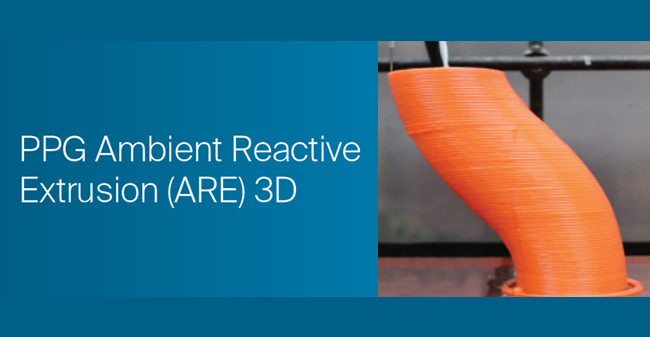As 3DPrint.com’s Matt Kremenetsky recently pointed out, centuries-old conglomerates are pushing into the 3D printing space, where smaller firms could give them an Industry 4.0 life raft as global economics and manufacturing enter a new era. The latest is PPG (NYSE: PPG), which has not only developed a proprietary 3D printing process but sold its first 3D printed parts to none other than Lockheed Martin for use on its C-130J Super Hercules military aircraft.
Co-developed with Oak Ridge National Laboratory in 2018, the process is called ambient reactive extrusion (ARE). The name derives from the fact that fluid thermoset materials are deposited onto a print bed and cured in the ambient air.

Image courtesy of PPG.
According to the company, “PPG’s ARE AM has demonstrated print speeds of at least 10 times faster thanis possible with current thermoplastic AM processes.” Not only that, but PPG claims that ARE is capable of producing “multimaterial, covalently bonded, isotropic, end-use parts at scale and speeds for aerospace, military and commercial applications.”
“With additive manufacturing, we’ve automated a manual process for producing these ramp seals,” said Cindy Kutchko, PPG senior group leader, additive manufacturing, aerospace. “By creating shelf-stable parts that are quick to install, we are able to save our customers significant production time and a cost savings of more than 30% compared to current manufacturing processes.”
Demonstrating these capabilities, PPG 3D printed ramp seals made from the company’s production qualified aerospace sealant for Lockheed Martin to install on its C-130J Super Hercules aircraft. This four-engine turboprop military transport aircraft is the latest in Lockheed’s Hercules series, used primarily for transporting soldiers to areas like Afghanistan and Libya, but orders for the plan have come from everywhere from Mongolia and Israel to Saudi Arabia and Mexico. Interestingly, the former CEO of Lockheed, Marillyn Hewson, chaired a Task Force on National Security and U.S. Manufacturing Competitiveness for the Reagan Institute, which issued a report that looks a lot like a Republican “New Deal”.
“These 3D printed components are a game-changer for the C-130J Super Hercules,” said Rod McLean, vice president and general manager of Lockheed Martin’s Air Mobility & Maritime Missions line of business. “PPG’s ARE technology is an outstanding example of how manufacturing innovation and evolution combine to deliver affordable, customized and durable components for our operators.”
The largest coatings company in the world, PPG is a paints, coatings, and specialty materials giant with a history spanning 138 years, $13.8 billion in revenues, and 47,3000 employees across over 70 countries. As such, thermosets are its specialty and the company boasts that “thermoset materials typically outperform thermoplastics in durability and chemical resistance.”
The company is already producing large scale parts using a machine featuring a 10 ft x 5 ft bed at its Application Support Center (ASC) in Los Angeles. Partnering with Cosine Additive, the company plans to expand its large-scale 3D printing capabilities. What this suggests is that Cosine will be building the machines and incorporating ARE printheads into their own architecture.
Cosine came onto the scene in 2015, before it began working with Essentium to develop a large-format 3D printer that could overcome z-axis weakness in thermoplastic extrusion 3D printing through the use of a plasma heat source and specialty filaments. Cosine was to provide the machine gantry and Essenitum the print head. While it looks as though Essentium may have moved onto its own architecture design, Cosine has found an even more powerful partner (if you discount BASF’s investment in Essentium).
Given PPG’s sheer weight in the world, it would be difficult not to imagine the chemicals giant not heaving that weight around and coming to dominate our small industry. This is particularly true because of the stated benefits of ARE, including isotropic physical properties—which have been the Achilles heel of material extrusion and many other additive manufacturing processes—as well as a broad material selection. Given that PPG already provides coatings, certified to a number of specific sectors and applications, to a wide range of customers globally, it will be able to get its technology into the market more quickly than might be possible otherwise.
Subscribe to Our Email Newsletter
Stay up-to-date on all the latest news from the 3D printing industry and receive information and offers from third party vendors.
Print Services
Upload your 3D Models and get them printed quickly and efficiently.
You May Also Like
Consolidation in AM: How 2025 Is Shaping the Industry’s New Normal
The first half of 2025 has been marked by a clear shift in the additive manufacturing (AM) industry. Companies are no longer just focused on developing new tech by themselves....
Etsy Design Rule Change Reduces Selection of 3D Printed Goods
Online marketplace Etsy has implemented a rule change requiring all 3D printed goods on the site to be original designs. The update to the site’s Creativity Standards states, ¨Items produced using...
U.S. Congress Calls Out 3D Printing in Proposal for Commercial Reserve Manufacturing Network
Last week, the U.S. House of Representatives’ Appropriations Committee moved the FY 2026 defense bill forward to the House floor. Included in the legislation is a $131 million proposal for...
Transforming From Tourist to Native: Duro CEO Michael Corr Explains Why the Company Rebuilt its PLM Software on AI
In these early innings of the AI boom, many market analysts have expressed concern that AI spend has gotten too far ahead of the technology’s proven ability to deliver significant...
































